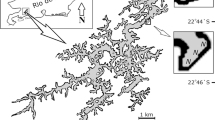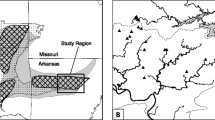Abstract
Approximately 20% of North American minnows are considered imperiled. The factors responsible for imperilment in this group are complex, but the relationship of spawning mode to conservation of North American minnows has not been explored. I provide a summary of the spawning modes of imperiled North American minnows, discuss patterns between these modes and conservation status, and predict the spawning modes for several poorly-known imperiled species. Of the 46 species of North American minnows that are imperiled, spawning modes are known for only 13 species. All spawning modes are represented in the imperiled group of minnows except mound-building and egg-clustering, and with the exception of crevice-spawners and pit-ridge-builders, the percentage of imperiled minnows in each category of spawning mode is roughly proportional to the percentage of minnows in that category overall. Species with complex spawning modes, such as mound-building, pit-building and egg-clustering, are among the most common fishes in North American streams. This pattern suggests that there is a relationship between parental care and success (lack of imperilment) in minnows. Spawning mode is an important consideration in the formulation of recovery plans and proactive conservation efforts.
Similar content being viewed by others
References cited
Angermeier, P. L. 1995. Ecological attributes of extinction-prone species: loss of freshwater fishes of Virginia. Cons. Biol. 9: 143-158.
Balon, E. K. 1975. Reproductive guilds of fishes: a proposal and definition. J. Fish. Res. Board Can. 32: 821-864.
Balon, E. K. 1990. Epigenesis of an epigeneticist: the development of some alternative concepts on the early ontogeny and evolution of fishes. Guelph Ichthyol. Rev. 1: 1-48.
Barber, W. E., D. C. Williams & W. L. Minckley. 1970. Biology of the Gila spikedace, Meda fuligda, in Arizona. Copeia 1970: 9-18.
Berkman, H. E. & C. F. Rabeni. 1987. Effect of siltation on stream fish communities. Env. Biol. Fish. 18: 285-294.
Brooks, D. R., R. L. Mayden & D. A. McLennan. 1992. Phylogeny and biodiversity: conserving our evolutionary legacy. Trends Ecol. Evol. 7: 55-59.
Coburn, M. M. & T. M. Cavender. 1992. Interrelationships of North American cyprinid fishes. pp. 328-373. In: R. L. Mayden (ed.) Systematics, Historical Ecology, and North American Freshwater Fishes, Stanford University Press, Stanford.
Cordone, A. J. & D. W. Kelley. 1961. The influences of inorganic sediment on the aquatic life in streams. Calif. Fish Game 47: 189-228.
Delco, E. A., Jr. 1960. Sound discrimination by males of two cyprinid fishes. Tex. J. Sci. 12: 48-54.
Eisenhour, D. J. & R. M. Strange. 1998. Threatened fishes of the world: Phoxinus cumberlandensisStarnes & Starnes, 19778 (Cyprinidae). Env. Biol. Fish. 51: 140.
Forrest, T. G., G. L. Miller & J. R. Zagar. 1993. Sound propagation in shallow water: implications for acoustic communication by aquatic animals. Bioacoustics 4: 259-270.
Gard, M. 1997. Threatened fishes of the world: Ptychochilus luciusGirad, 1856. Env. Biol. Fish. 49: 332.
Gorman, O.T. & D.M. Stone, 1999. Ecology of spawning humpback chub, Gila cypha, in the Little Colorado River in Grand Canyon, Arizona, Env. Biol. Fish. 55: 115-133 (this issue).
Hankinson, T. L. 1932. Observations on the breeding behavior and habits of fishes in southern Michigan. Pap. Mich. Acad. Sci. Arts Lett. 15: 411-425.
Hubbs, C. & K. Strawn. 1956. Interfertility between two sympatric fishes, Notropis lutrensisand Notropis venustus. Evolution 10: 341-344.
Jenkins, R. E. & N. M. Burkhead. 1984. Description, biology and distribution of the spotfin chub, Hybopsis monacha, a threatened cyprinid fish of the Tennessee River drainage. Bull. Alabama Mus. Nat. Hist. 8: 1-30.
Jenkins, R. E. & N. M. Burkhead. 1994. Freshwater fishes of Virginia. Amer. Fish. Soc., Bethesda. 1079 pp.
Johnston, C. E. 1994a. The benefit to some minnows of spawning in the nests of other species. Env. Biol. Fish. 40: 213-218.
Johnston, C. E. 1994b. Nest association in fishes: evidence for mutualism. Behav. Ecol. Sociobiol. 35: 379-383.
Johnston, C. E. & L. M. Page. 1992. The evolution of complex reproductive strategies in North American minnows (Cyprinidae). pp. 600-621. In: R. L. Mayden (ed.) Systematics, Historical Ecology, and North American Freshwater Fishes, Stanford University Press, Stanford.
Johnston, C. E., J. S. Ramsey, S. T. Sobaski & C. K. Swing. 1995. Introduced species of fishes in the southern Appalachians: consequences for conservation. J. Tenn. Acad. Sci. 70: 65-76.
Johnston, C. E. & J. R. Shute. 1997. Spawning behavior of the blue shiner (Cyprinella caerulea) and the holiday darter (Etheostoma brevirostrum), two rare fishes of the Conasauga River, Georgia and Tennessee. Proc. Southeast. Fish. Counc. 35: 1-2.
Jonez, A. & R. C. Sumner. 1954. Lakes Meade and Mohave investigations. Nevada Fish and Game Comm., Carson City. 174 pp.
Karp, C. A. & H. M. Tyus. 1990. Humpback chub (Gila cypha) in the Yampa and Green rivers, Dinosaur National Mounument, with observations on roundtail chub (G. robusta) and other sympatric fishes. Great Basin Nat. 50: 257-264.
Lee, D. S., C. R. Gilbert, C. H. Hocutt, R. E. Jenkins, D. E. McAllister & J. R. Stauffer, Jr. 1980. Atlas of North American freshwater fishes. N. C. State Mus. Nat. Hist., Raleigh. 854 pp.
McMillian, V. E. & R. J. F. Smith. 1974. Agonistic and reproductive behavior of the fathead minnow (Pimephales promelasRafinesque). Z. Tierpsychol. 34: 25-58.
McNatt, R. M. 1974. Re-evaluation of the native fishes of the Rio Yaqui in the United States. Proc. West. Assoc. State Game Fish Comm. 54: 273-279.
Master, L. 1990. The imperiled status of North American aquatic animals. Biodiversity Network News 3: 1-8.
Maurakis, E. G. & J. J. Loos. 1984. Nest building and spawning of Semotilus lumbee(Pisces: Cyprinidae). Assoc. Southeast. Biol. Bull. 31: 34.
Miller, R. J. 1962. Reproductive behavior of the stoneroller minnow, Campostoma anomalum pullum. Copeia 1962: 407-417.
Minckley, W. L. 1973. Fishes of Arizona. Arizona Game and Fish Department, Phoenix. 293 pp.
Minckley. W. L. & W. E. Barber. 1971. Some aspects of biology of the longfin dace, a cyprinid fish caracteristic of streams in the Sonoran Desert. Southwest. Nat. 15: 459-464.
Minckley, W. L. & S. P. Vives. 1990. Cavity nesting and male nest defense by ornate minnow, Codoma ornata(Pisces: Cyprinidae). Copeia 1990: 219-221.
Moyle, P. B. 1976. Inland fishes of California. University of California Press, Berkeley. 405 pp.
Moyle, P. B. & R. A. Leidy. 1992. Loss of aquatic ecosystems: evidence from fish faunas. pp. 127-169. In: W. L. Minckley & J. E. Deacon (eds) Battle Against Extinction, University of Arizona Press, Tucson.
Moyle, P. B. & J. E. Williams. 1990. Biodiversity loss in the temperate zone: decline of the native fish fauna of California. Conservation Biology 4: 275-283.
Noakes, D.L.G., F.W.H. Beamish & A. Rossiter. 1999. Age and growth of the lake sturgeon, Acipenser fulvescens, in northern Ontario: conservation implicaitons. Env. Biol. Fish. 55: 135-144(this issue).
Page, L. M. & B. M. Burr. 1991. A field guide to freshwater fishes. Houghton Mifflin Co., Boston. 432 pp.
Page, L. M. & C. E. Johnston. 1990. The breeding behavior of Opsopoeodus emilae(Cyprinidae) and its phylogenetic implications. Copeia 1990: 1176-1180.
Page, L. M. & P. W. Smith. 1970. Recent range adjustments and hybridization of Notropis lutrensisand Notropis spilopterusin Illinois. Trans. Ill. Acad. Sci. 63: 264-272.
Rabito, F. F. & D. C. Heins. 1985. Spawning behavior and sexual dimorphism in the North American cyprinid fish Notropis leedsi, the bannerfin shiner. J. Nat. Hist. 19: 1155-1163.
Rakes, P.L., J.R. Shute & P.W. Shute. 1999. Reproductive behavior, captive breeding, and restoration ecology of endangered fishes. Env. Biol. Fish. 55: 31-42(this issue).
Raney, E. C. 1939. Observations on the nesting habits of Parexoglossum lauraeHubbs and Trautman. Copeia 1939: 112-113.
Raney, E. C. 1940a. The breeding behavior of the common shiner, Notropis cornutus(Mitchill). Zoologica 25: 1-14.
Raney, E. C. 1940b. Reproductive activities of a hybrid minnow, Notropis cornutusx Notropis rubellus. Zoologica 25: 361-367.
Reighard, J. 1910. Methods of studying the habits of fishes, with an account of the breeding habits of the horned dace. Bull. U. S. Bur. Fish. 28: 1111-1136.
Reighard, J. 1943. The breeding habits of the river chub, Nocomis micropogon(Cope). Pap. Mich. Acad. Sci. Arts Lett. 29: 397-423.
Ross, M. R. 1977. Aggression as a social mechanism in the creek chub (Semotilus atromaculatus). Copeia 1977: 393-397.
Smith, P. W. 1971. Illinois streams: a classification based on their fishes and an analysis of factors responsible for disappearance of native species. Ill. Nat. Hist. Surv. Biol. Notes 76. 14 pp.
Smith, P. W. 1979. The fishes of Illinois. University of Illinois Press, Urbana. 314 pp.
Snelson, F. F. & R. D. Suttkus. 1978. A new species of Semotilus(Pisces: Cyprinidae) from the Carolinas. Bull. Ala. Mus. Nat. Hist. 3: 1-11.
Starnes, L. B. & W. C. Starnes. 1981. Biology of the blackside dace Phoxinus cumberlandensis. Amer. Midl. Nat. 106: 361-371.
Stout, J. F. 1975. Sound communication during the reproductive behavior of Notropis analostanus(Pisces: Cyprinidae). Amer. Midl. Nat. 94: 296-325.
Van Duzer, E. M. 1939. Observations on the breeding habits of the cut-lips minnow, Exoglossum maxillingua. Copeia 1939: 65-75.
Vanicek, C. D. & R. H. Kramer. 1969. Life history of the Colorado squawfish, Ptychocheilus lucius, and the Colorado chub, Gila robusta, in the Green River in Dinosaur National Monument, 1964–1966. Trans. Amer. Fish. Soc. 98: 193-208.
Vinyard, G. L. 1997. Threatened fishes of the world: Eremichthys acrosHubbs & Miller, 1948 (Cyprinidae). Env. Biol. Fish. 51: 140.
Vives, S. P. 1990. Nesting ecology and behavior of hornyhead chub Nocomis biguttatus, a keystone species in Allequash Creek, Wisconsin. Amer. Midl. Nat. 124: 46-56.
Vives, S. P. 1993. Choice of spawning substrate in red shiner with comments on crevice spawning in Cyprinella. Copeia 1993: 229-232.
Vives, S. P. & W. L. Minckley. 1990. Autumn spawning and other reproductive notes on loach minnow, a threatened cyprinid fish of the American Southwest. Southwest. Nat. 35: 451-454.
Veshchev, P. V. & A. S. Novikova. 1983. Reproduction of the stellated sturgeon Acipenser stellatus(Acipenseridae) under regulated flow conditions in the Volga River. J. Ichthyol. 23: 42-52.
Wallace, R. K. & J. R. Ramsey. 1981. Reproductive behavior and biology of the bluestripe shiner (Notropis callitaenia) in Uchee Creek, Alabama. Amer. Midl. Nat. 106: 197-200.
Warren, M. L. & B. M. Burr. 1994. Status of freshwater fishes of the United States: overview of an imperiled fauna. Fisheries 19: 6-18.
Warren, M. L. & B. M. Burr. 1998. Threatened fishes of the world: Notropis albizonatusWarren, Burr & Grady, 1994 (Cyprinidae). Env. Biol. Fish. 51: 128.
Wallin, J. E. 1992. The symbiotic nest association of yellowfin shiners, Notropis lutipinnis, and bluehead chubs, Nocomis leptocephalus. Env. Biol. Fish. 33: 287-292.
Williams, J. E., J. E. Johnson, D. A. Hendrickson, S. Contreras-Balderas, J. D. Williams, M. Navarro-Mendoza, D. E. McAllister & J. E. Deacon. 1989. Fishes of North America endangered, threatened, or of special concern: 1989. Fisheries 14: 2-20.
Author information
Authors and Affiliations
Rights and permissions
About this article
Cite this article
Johnston, C.E. The Relationship of Spawning Mode to Conservation of North American Minnows (Cyprinidae). Environmental Biology of Fishes 55, 21–30 (1999). https://doi.org/10.1023/A:1007576502479
Issue Date:
DOI: https://doi.org/10.1023/A:1007576502479




